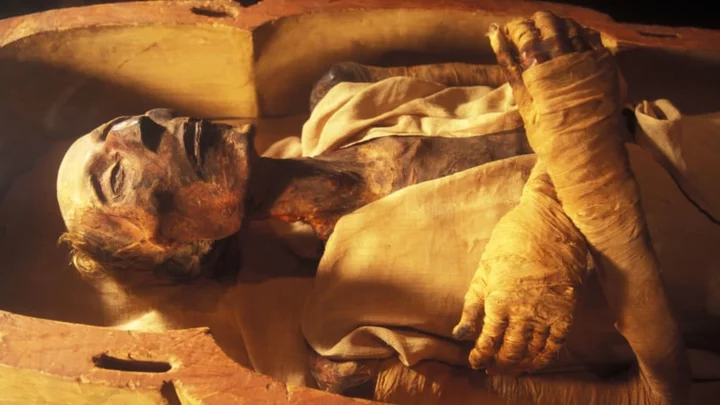Ancient Egypt captivated cultures around the world long after its heyday. Egyptomania can be seen everywhere from early 19th-century French architecture to American fashion in the 1920s to Hollywood epics. But before the Egyptian Revival or Tutmania, Europeans in the Middle Ages were taking their Egypt obsession to disturbing places. Many of them were desperate to get their hands on an authentic piece of mummy—not to own as an artifact, but to ingest as medicine.
The medieval mummy-eating fad can’t be explained by Egyptomania alone. An unfortunate linguistic misinterpretation led many people to think a mummified hunk of human flesh could cure a range of ailments, from bruising to bubonic plague. Mummy derives from mumia, a Persian term for bitumen or pitch. The naturally occurring, sticky black substance, a semi-solid form of crude oil, is best known as a building material, and centuries ago it was commonly used for medicinal purposes as well. It was both ingested and applied topically to treat condition like coughs, rashes, and broken bones.
When Europeans first observed Egyptian mummies, they made note of the black gunk (a combination of oil, fat, resin, beeswax, and bitumen) covering the preserved bodies. They thought it resembled mumia, so they named the corpses mummies after the material. That’s where the confusion began: People heard the word mummy and assumed it had the same healing benefits as bitumen. They began seeking out mummies not just for the pitch-like coating on the bodies, but for the centuries-old flesh itself. Soon, mummy and mumia lost any meaningful distinction.
People in medieval Europe used medicinal mummies the same ways they used bitumen. Some applied it directly to the affected area, while others ground the dried flesh and bones into a powder and mixed it in their drinks. The public viewed ancient Egypt with awe during this period, and it wasn’t a stretch for them to believe medicine made from pharaohs would imbue them with divine protection. But this was another misunderstanding; the mummies found coated in black resin and shipped to European apothecaries were almost always peasants and never royalty.
Despite its misguided origins, the Medieval mummy-eating trend continued for roughly 500 years. Mumia was so popular that European explorers returning from Egypt weren’t able to supply enough cadavers to meet demand. When inventory dwindled, apothecaries started supplementing mummies with products made from fresh human meat, further removing mumia from its etymology.
In some cases, patients didn’t even have to be tricked into dining on the recently deceased. Eating fresh flesh and blood become a fad in itself, with many doctors claiming such remnants had more life-giving properties compared to the desiccated husks that had been sitting in tombs for centuries. They were also easier to come by than genuine mummies from Cairo. People who couldn’t afford to go to the apothecary would sometimes hang around executions, where the executioner might sell them a cup of the condemned’s blood at a bargain price.
By the 18th century, using human meat (mummified or otherwise) as a cure-all had started to fall out of fashion in Europe. Mummy parts had become a rarer sight on medicine shelves, but that didn’t mean Westerners were over their Egyptian obsession. They were still enamored with the legendary civilization, but instead of eating its long-dead citizens, they channeled it through artistic expression. Though art and architecture couldn’t cure internal bleeding or the plague, it was a much healthier form of Egyptomania than what Europeans had been practicing for centuries.
This article was originally published on www.mentalfloss.com as How an Unfortunate Misunderstanding Spawned a Medieval Mummy-Eating Fad.









